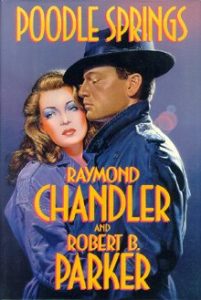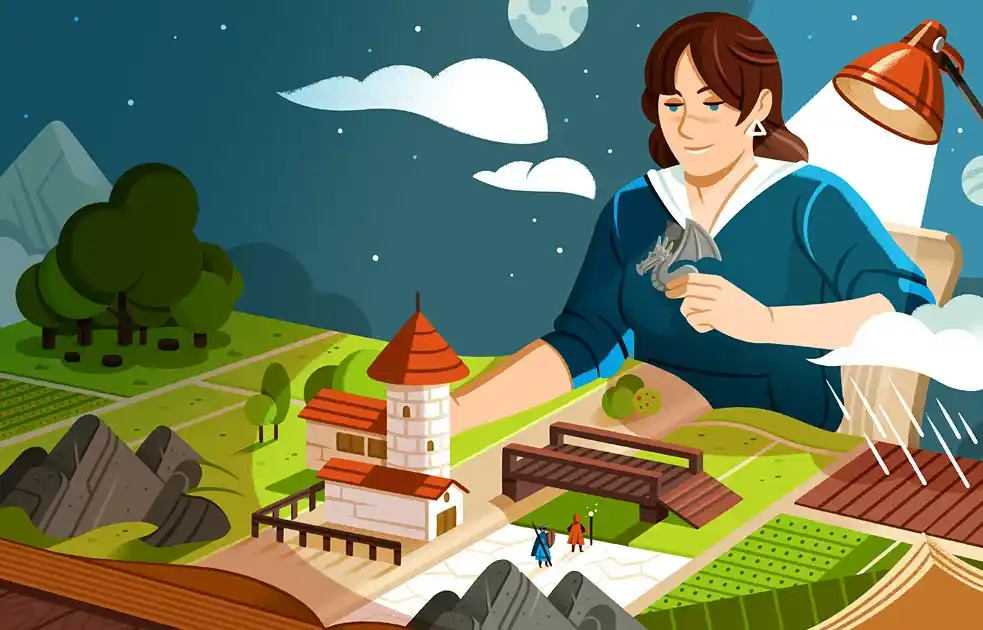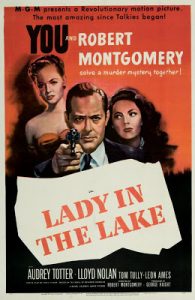Last updated on Oct 15, 2025
How to Write a Series: 5 Fundamental Tips for Expanding Your Story
Martin Cavannagh
Head of Content at Reedsy, Martin has spent over eight years helping writers turn their ambitions into reality. As a voice in the indie publishing space, he has written for a number of outlets and spoken at conferences, including the 2024 Writers Summit at the London Book Fair.
View profile →Let’s be honest: many (if not most) writers would jump at the chance to join the ranks of household names like J. R. R. Tolkien, J. K. Rowling, and George R. R. Martin. But what do these authors have in common? Well, they all have at least two punctuation marks in their pseudonyms — but more importantly, they wrote stories that span multiple books, transporting fans to another reality. If you're not keen to add multiple periods to your name, don't worry: today, we’re just going to focus on how to write a series.
Writing a series is serious (or rather, series-ous) business. When done right, it can be an incredibly effective marketing strategy for indie authors. So grab that mind-boggling, spine-tingling, rip-roaring story idea you hope to continue writing about for years to come, and let’s jump into the basics of serial writing.
1. Determine the type of series that best suits your story
The first thing to do is figure out which kind of series suits your story idea. This will affect the way the following tips apply to you. Think about the series written by your favorite authors. Chances are that they all fall into one of these categories
- Serial: featuring one overarching narrative told in several, chronological installments
- Episodic: each book can be read in any order, featuring one consistent protagonist
- Interlinked: a series that features a cast of characters within the same universe
Serialized stories
Serialized stories are probably the first thing that pops into your head when you think of a series: it’s a collection of books that flow from one to the next in chronological order. To be properly understood, the series must be read in this order. The key to writing a serial is to create a central plot along which the individual books and the lead character’s story will line up.
The Harry Potter books are perhaps the best-known modern example of a serial. The thread that binds the series is the external arc of Voldemort vs. the Wizarding World that parallels Harry's internal arc of going from a neglected orphan to a self-sacrificing hero.
Episodic series
In an episodic series (sometimes called procedural series), each story is self-contained, and you have a strong protagonist that audiences can’t help but get attached to.
In this scenario, readers relish each book on its own, and the main connection between the volumes isn’t one ongoing storyline, but the static lead character. Think of mystery novels — there is always an eccentric, outstanding investigator who acts as an anchor for the entire series.
Raymond Chandler’s hardboiled detective series starring Philip Marlowe is the perfect example of an episodic series. Readers follow the righteous and individualist private eye as he uncovers the various mysteries of 1940s California. Chandler actually started out with short stories in pulp magazines before fixing them up into the now-famous episodic novels.
Interlinking series
The unifying thread of an interlinking series is that it all occurs within the same universe. Each book may follow a different protagonist, some of whom can be related to one another. Similar to episodic series, readers can enjoy interlinked books in any order. There may be some rewards to reading it in the order of publication, but those will mainly be Easter eggs and nothing of great importance to the overall series.
An acclaimed example of this is The Century Trilogy by Ken Follett, which follows five families from five countries across the 20th century as they struggle, from generation to generation, through two world wars and the Cold War.
To determine which type of series you should go with, look back at your first book (or its conception). If it’s already published, also consider the feedback from your readers. Answer the following questions:
- Are there some loose ends in Book One — e.g., a deep dark secret in the protagonist’s back story, or a sinister appearance of a powerful villain — that you can further map out?
- Can your main characters experience more substantial growth, or are they more grounded and static?
- What do your readers seem to love the most about your stories — the evolving characters, the thrilling plot, or the world you’ve created?

2. Plan... but only as much as you need to
Not every type of series requires the same amount of prior planning. For instance, if you’re a committed free-writer, you’re probably interested in writing an episodic series, as it’s not necessary to have an overarching narrative connecting the different books. Authors writing serials, on the other hand, typically know how the whole thing will end even before they start writing and put pen to paper; the same applies to authors writing books in three.
Still, not having any plan is a huge pitfall when it comes to serial writing. So let’s dig in further to the kind of planning required for each type of series.
Serialized stories: outline your big arc
Perhaps it helps to think of a chronological series as one gigantic novel divided into smaller sections. The stories that run through these installments are thus all leading up to the final moment where the central problem is resolved.
With that in mind, you’ll want to sketch out certain key points within your series, and that includes the ending. You don’t have to know every detail about the final high point, and some of your preconceptions might change as you write. Using Harry Potter as an example, here are a few of the things you may wish to nail down:
How the story starts. Harry Potter finds out he’s a wizard and is accepted to Hogwarts.
How the story ends. After the final battle at Hogwarts, the wizarding world is saved.
What the entire series’ final climax will be. The ultimate face-off between Harry and Voldemort.
A loose idea of how the main characters will develop to get to the end. Harry will come of age over six years of magical schooling and face Voldemort several times before their final battle.
You can use the climax and final resolution as your guiding stars as you sketch out the individual volumes. Every book should bring the characters and readers closer to that endpoint. Most of the time, having an outline also helps you determine how many books you’ll write (J. K. Rowling mapped her seven books onto seven years of schooling at Hogwarts).
Episodic series: construct a gentle flow
Unlike serials, there’s no pressure to know where your characters will end up or build towards an overarching climax in an episodic series. Your series can continue on for as long as you have new stories to tell.
However, rather than planning five books ahead, you might want to draft an in-depth character sheet for your protagonist. As we know, strong, memorable protagonists are what steer an episodic series to success. And while they remain fairly static, you can plan for layers of your main character to be peeled back throughout the series, like an onion. This can be their backstory, personality, relationships, etc. Alternatively, you can introduce minor changes in their lives, like shifts in their careers or living situations.
Take, for instance, Detective Philip Marlowe, who is not unlike many literary detectives: a lone wolf with no sidekick and little personal attachments with others. Yet in The Long Goodbye, the sixth in the series, Marlowe forges a friendship with a drunken veteran who ends up committing suicide. When the veteran’s name is suddenly brought up as a suspect for an unsolved murder case, Chandler reveals to readers a new, tender side of Marlowe as he strives to protect his new friend’s legacy.

In the same volume, he also begins his love affair with Linda Loring, whom he marries later in the series. So while Marlowe doesn’t undergo any considerable change, he’s not a one-dimensional character either.
Small developments like these give your hero complexity and make the series more compelling and lovable. So once you figure out who your protagonist is, you might want to sketch out how you can slowly show readers different sides of them throughout the novels.
Top tip: Keep track of these developments using a character profile.
Interlinking series: find a societal shift
As with an episodic series, planning is not paramount for interlinked stories, since the consequences of one book tend not to spill into the next one. However, here are some connecting elements you might want to sketch out.
Overarching Themes
Will there be any themes that are consistently explored in new ways in each installment? Follett's Century Trilogy chronicles five families’ struggle for livelihood and freedom throughout the turbulent 20th century.
The World
While the characters might change from one book to another in an interlinked series, each story tends to take place in one world. The Century Trilogy takes place effectively in our world. The books chronicle a society changed by war, where disruptions in worldwide governmental systems have forced families into difficult situations. Disparate characters are forced to migrate and are thus brought together without them realizing it.
The Timeline
Timelines are particularly vital if you intend to move between periods in each book. If you're writing a historical fiction series (think the Century Trilogy or Hilary Mantel's Wolf Hall series, then you will ideally remain faithful to the facts (unless you consciously choose to deviate from history). However, if you're working within an invented timeline (such as in Terry Pratchett's Discworld books), you may want to sketch out what the years or decades before your stories looked like — and keep track of any events in your books that will have knock-on effects on characters in other entries.
Relationships
While each book in an interlinked series can be read as a standalone novel, readers love to find tie-ins when it comes to series. One great way to do this is to establish the characters of various books. For example, the protagonists of Book Two in The Century Trilogy are descendants of the protagonists of Book One. Meanwhile, the family trees interweave as some of the characters fall in love with each other.
Think about these connections before writing to seamlessly bring your stories together and sneak in teasers to encourage your readers to buy other books in the series!
3. Dive in and expand your world
While there are many differences between the three types of series, one thing is consistent: they all need a well-crafted world in which the stories unfurl. Here a couple of tips to bring the universe of your series to life.

FREE RESOURCE
The Ultimate Worldbuilding Template
130 questions to help create a world readers want to visit again and again.
Reuse existing features
Whether you’re writing episodically or trying to hint at overarching developments, callbacks can be a great way to reinforce the atmosphere of your series. Dive into the realm you’ve created and find elements or themes that you can tease out or refine. The important thing is not only to repeat these details but to also give them some nuances, and here are some ideas as to how.
Retroactively plant a gun (of Chekhov's)
You can rework features and innocuously add significance to them as you go. With careful execution, the readers might end up thinking you’ve been planning it all along! For example, in Harry Potter, the art of prophesying introduced in The Prisoner of Azkaban becomes much more important in later books. It ignites the final battle in The Order of the Phoenix and reveals the motivation behind Voldemort’s murder of Harry’s parents. Without it, Harry wouldn’t be the Chosen One.
Reward careful readers with Easter eggs
Episodic and interlinking series can also benefit from recurring elements. It gives the audience pleasure to notice familiar details when they read. For instance, a keen reader of The Century Trilogy might notice that George Jakes — the protagonist of Book Three — is the grandson of Lev Peshkov, who ran from the oppression of Tsarist Russia to America in the first book. In a gratifying moment, after generations of defying oppression, Jakes watches as Obama becomes President: a moment of triumph for the marginalized communities of the US. It’s a small detail, but one that that will pay off for loyal readers.
Expand your horizon
While you want to have some reappearances, no one will keep buying your books if they deal with the same circumstances again and again. To keep your readers interested in and excited about new volumes, you should come up with new places your characters can visit and new problems they have to solve. Consider some of the following options.
Create new institutions
This refers to either literal institutions or to traditions. For example, The Goblet of Fire does both: Harry (and the reader) is introduced to other magical schools in Europe and long-held practices like the Quidditch World Cup and the Triwizard Tournament.
Visit a new location
Let the adventures take your character to a new place in your world to change things up. In The Lady in the Lake, Marlowe takes a break from the busy city to solve a case in the secluded mountains of California.

Follow new occupations
This applies a lot more to interlinking series, where you have more characters to try new things with. Rather than let all the characters in the trilogy be politicians and spies, for instance, Ken Follett introduced protagonists in Book Three who are international music sensations. Not only is it exciting for readers, but it’s also a refreshing change for you!
4. Leave no character unexamined
When we said characters are important, we don’t just mean the protagonists. They no doubt deserve the largest portion of your time, but they don’t exist on their own. Throughout their journeys, they’ll interact with many others, from enemies to friends, who’ll bring out the worst or best in our protagonists, so these side characters must have some complexity and development as well. As such, to write a good series, you should remember the following tips when it comes to the characters.
Add depth to your sidekicks
Most characters don’t succeed on their own — they need help from others. These friends are as important to the plot as the protagonists and should have a life of their own — one that includes increasing challenges and development, and that somehow intertwines with the hero’s.
Think about Ron and his journey to overcome his self-doubt. He continually struggles with being in Harry’s shadow, which often results in Ron ignoring Harry in his times of need. But, as the series progresses, Ron earns some glory for himself: he becomes Prefect, he eventually wows the crowd as a Quidditch champion, and he comes back to save Harry’s life when he’s trying to retrieve the Sword of Gryffindor. He realizes, through the many times that they reconciled, that friendship is more important than pride.
Top tip: Diversify your character types to create more nuanced stories.
Give secondary characters resolutions
Along the same lines, we can think of characters who aren’t sidekicks, but who play significant roles in the story still. This is especially true in interlinking stories that often go around a circle of friends or family members. Those who play secondary roles can become the heroes in a later book, while those who are heroes may retreat into the background a little. In either case, they shouldn’t be forgotten.
In The Century Trilogy, Ethel Leckwith, the primary character in Fall of Giants (Book One), steps back to take a supporting role in the later volumes, as her son and grandson go on to change the world. Throughout the three books, readers learn of her success as she rises from her difficult childhood working as a housemaid to become a well-loved politician.
Give background characters some purpose
Readers tend to root for the dark horse, so don’t take your background character lightly. You can pleasantly surprise your audience by giving a minor character who’s always been around an exciting new role to play. This role doesn’t have to be grand, but it still gives them a moment in the limelight. Anyway, it’s not believable if your hero takes all the credit for resolving the central conflict.
In Harry Potter, Neville Longbottom starts out as a dorky little kid in Harry’s year. He doesn’t accompany Harry the way Ron and Hermione do, but his “other Chosen One” fate was not for nothing: he helps bring down the Dark Lord by destroying the final Horcrux.

5. Make sure each book satisfies on its own
When actually drafting their books, a lot of series writers fall into the trap of writing filler novels. Sure, your books are part of something bigger than each individual title, but readers will buy them one by one, so you have to make sure each one is complete and unique. Otherwise, you risk losing the audience’s interest. This means that:
- Each book has a complete plot that is resolved — that means no “mushy middle” and filler books for serials; and
- Individual plots are not repetitions of one another (different names and places alone do not make the story unique).
If you’re thinking, “Hang on a minute, the Lord of the Rings trilogy doesn’t really have individual plots for each of volumes,” then we’re here to tell you that’s an exception. In any case, Tolkien’s initial idea was to publish a single epic novel rather than a series. As such, Lord of the Rings is actually not a good example to base your work on. Instead, consider how every Harry Potter book has its own self-contained adventure. There's no book where the only satisfying resolution is Harry managing to finish his potions homework on time.
Here are some suggestions to help you ensure that every book can stand on its own.
Look back on your summaries and plans
When you plan new volumes, take note of existing stories so that you don’t subconsciously conjure up the same adventure, only in different clothing.
This is also when you really see the power of planning ahead, because the overarching plot, general character developments, and recurring themes are great stems to branch out from.
A note for serial writers: find different ways to recap details about past events, characters, or locations that impact the plot in the present. Sometimes, readers forget what happened several books ago, especially if a lot of time has passed between the publications. Other times, someone might pick up your Book Five before anything else — and you’d want them to enjoy the book so much that they search for Book One, right?
J. K. Rowling does this frequently. She brings back wandmaker Mr. Ollivander in the final installment, and not just by name. She reminds readers that he’s the one who sold Harry his wand, reiterating that he noted the peculiar link between Harry’s wand and Voldemort’s.
Try out different structures
If you really need inspiration for writing new adventures, try switching up your story structure. Say you've been writing in the third person perspective all along, and are now looking for new inspiration. Why not try out the first-person perspective? In Lee Child's enormously popular Jack Reacher books, he deviated from his standard third-person limited POV and wrote The Enemy and Killing Floor (amongst a few others) in the first person.
Or don't be afraid to incorporate different ideas and conflicts into one book. Raymond Chandler frequently used a technique he called “cannibalizing,” in which he reworked his short stories (some of which didn't even feature Marlowe) to get novels with separate mysteries that eventually intertwine, like in The Big Sleep.
While the first three Harry Potter books focus on a critical challenge, e.g., someone trying to steal the Sorcerer’s Stone, The Goblet of Fire shakes up the format by providing Harry with three major obstacles to conquer.
Know when to end
This applies especially to episodic and interlinking series because there’s the temptation to carry on indefinitely — which is understandable. You’ve worked so hard to create a loyal fanbase that the decision to wrap things up won’t come easily.
At some point, however, you’ll either have used up all the potential there is in your characters, or you’ll feel that there are no longer new and exciting stories to be told within your world. (Historical fiction writers have it easy — there’s often a timeframe that they can work their series into, as with The Century Trilogy.) When that time comes, remember that it’s better to end on a strong note than to fizzle out long after you and your readers have lost interest.
Meet the top book editors for your series on Reedsy
Laura J.
Available to hire
Experienced editor with a passion for helping authors fulfill their vision. I edit many genres, including fantasy, romance, sci-fi, and YA.
Hilari C.
Available to hire
I am a sharp-eyed, award winning editor with over thirty years in the romance industry. I'll help you tell your story and find your readers!
Liz W.
Available to hire
Copy Editor and Proofreader with a background in philosophy, art, and critical theory. Well versed in computer and technology editing.
And on that note, it’s time for us to cap this list of tips to help you build your series. Maybe you can think of it as taking the basics of storytelling and adding layers to it. Take it as permission to extensively discover every little alleyway of your imagination before sharing with the world what you found!









